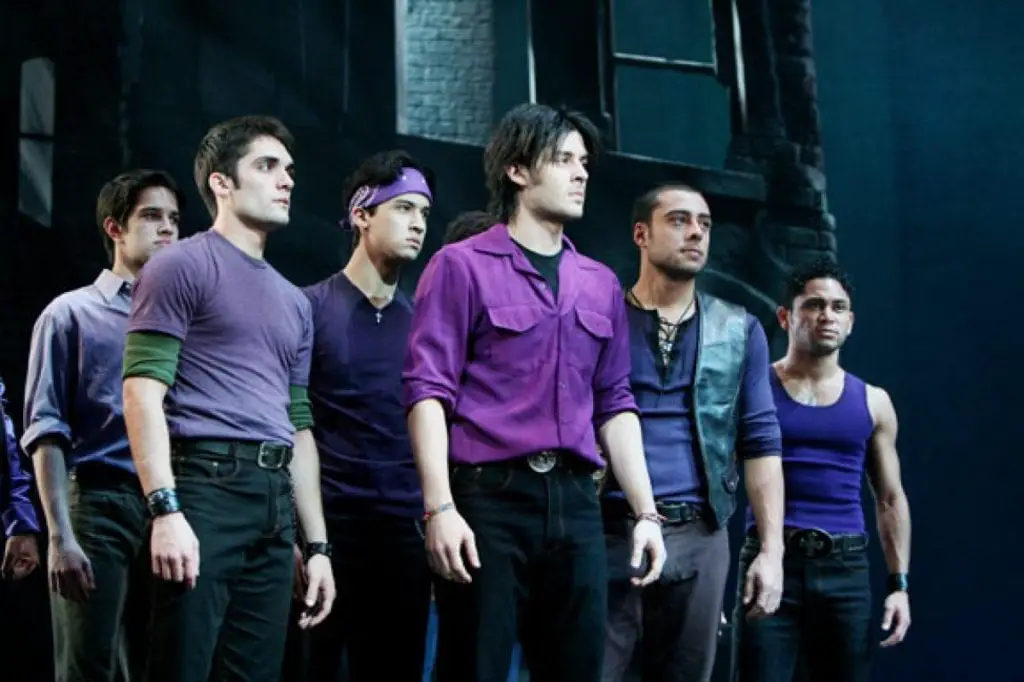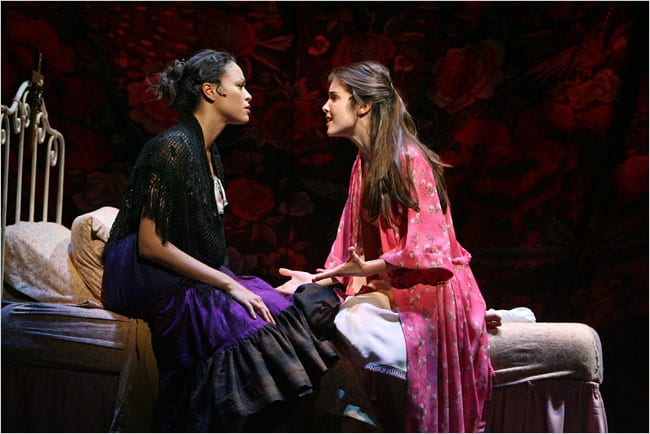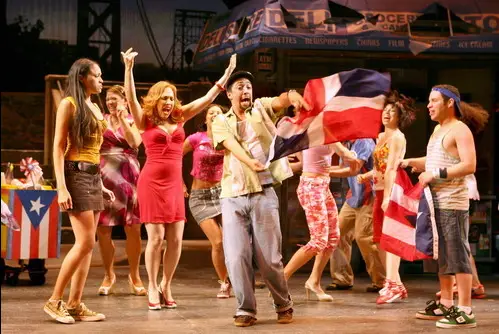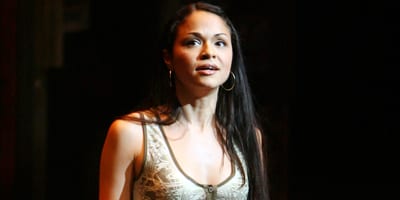Full disclosure: when I say I’ve become a musical fan, what I actually mean is that I have become a fan of a select few musicals. Somehow, it seems that the criterion I subconsciously adopted for me to get into any new musical has been that the story has to be about the life and struggles of Caribbean immigrants in New York City. Don’t ask me why.
Shockingly, Hamilton, although it absolutely fits this preference of mine, it won’t be featured in this article. Indeed, what I will try to explore and analyze is the way the Spanish language is used in West Side Story and In the Heights to convey identity and values.
For the purposes of this article, I will only be discussing the West Side Story Broadway revival of 2009, since it is the only version that includes full dialogues and songs in Spanish. The translation from the original English was actually provided by Lin-Manuel Miranda, so since he is also the artist behind In the Heights, the post covers the way this particular playwright uses the beautiful language that is Spanish to express identity struggles for the characters in either play.
Let’s start with the long established West Side Story. Two gangs opposing each other, a Romeo and Juliet romance flourishing in their midst. On one side, you have the Jets, children of Polish immigrants who speak English and are treated as Americans. On the other side, the Puerto Ricans straight from their island, the Sharks, who speak Spanish.

Who better to start things off than the leader of the Sharks himself, Bernardo? Due to the very cold welcome he received from the Jets and society alike, Bernardo is defined by his strong opposition to everything American. He is a very traditional man who has rejected the world he immigrated to and as a result, he consistently insists on speaking Spanish, which for him represents Puerto Rico and its traditional values.
“En Puerto Rico, las mujeres conocen su lugar.” −Bernardo
On several occasions, we see him speaking Spanish to all his fellow Puerto Rican, even to those who prefer English. This is especially striking during a long discussion mostly between him and Anita (a fervent American lover at that time, as we will see below) in which they discuss his love for Puerto Rico and how much he longs to go back, and her disdain for it and how she’s happy to be here in America. Bernardo keeps speaking to her in Spanish, and she keeps answering in English. In fact, the single English sentence he uses during that whole argument is when he asks Anita if she wants him to be American, since she seems to love America that much. After she stays silent, he switches back to Spanish, affirming once again his strong Puerto Rican identity.
The only people Bernardo seems willing to speak English to are the Jets, and even then is only to negotiate the terms of the rumble, when they need to understand each other. And even with them, he still speaks Spanish on multiple occasions when he tries to sound dominant and important.
His sister Maria is much more flexible with the way she uses Spanish. Generally speaking, Maria adapts to whichever person she’s talking to, using their native language unless she wants to make a special point. As she has just arrived from Puerto Rico a month before the musical takes place, her natural reflex is still to speak Spanish. She speaks it with Bernardo, her parents, and with the Shark girls. But with Tony, she speaks mostly English. Even so, I think there are significant exceptions to this rule.
In the scene that introduces Maria and Anita, Maria starts off by using Spanish to ask a favor of Anita, lowering the neck of her dress she will wear to the dance at the gym. Anita plainly refuses to answer her at all. Then, Maria intently uses English to try and convince her. Here again, the imagery of Spanish being used to represent more traditional values is used, with Maria using English to ask for a more revealing dress, like the dresses worn by the Jet girls. In fact, when later Bernardo asks her (in Spanish) why this night out is so important to her, she starts out in Spanish, as always when talking to her brother, but catches herself and switches to English to reply that this night is the beginning of her life as a young lady in America, that is, breaking away from Puerto Rican values. Note that she fulfills that promise later that night by making out with a boy against her brother’s wishes.
The situation with Anita doesn’t remain as simple throughout the musical. After Bernardo’s death, Anita has a change of heart, rejecting her former love for America, and therefore only addressing Maria in Spanish.
“Piensa en los tuyos, solo en los tuyos.” −Anita
When Maria tries to convince her that Tony is the right man for her, she adapts to this change of heart, and they share a song in Spanish where each is trying to reach out to the other (“Un Hombre Así”)—Maria to make Anita accept her love for Tony, Anita to beg her to reconsider. However, failing to convince Anita, Maria decides to once again call back to English, tries to snap Anita out of her grief and of the position she’s stuck in. Only then, using English, does she manage to prompt the reaction she wanted out of Anita, who accepts that her love for Tony is genuine and deserves to be lived. Just as when Bernardo used it, here Spanish represents the sense of sticking together with only Puerto Ricans, and English symbolizes mixing together with the “others”. Maria’s use of English allowed her to bring Anita back into the mindset she’d been in originally, if just temporarily.
Then there is Maria and Tony.
“Te adoro, Anton.”
“Te adoro, Maria.”
Although most of their conversations happen in English, due to the fact that Tony isn’t fluent in Spanish, they do share a few words in Spanish. Here, Spanish represents Maria’s deeper self and whatever she tells Tony in Spanish feels more genuine and intimate.
Tony himself speaks his sparse Spanish similarly, to express his feelings towards Maria perhaps more authentically. He also uses it with Anita to try to reach out to her, gain her trust. Despite it, though, Anita remains unconvinced.
“Buenas noches.”
“It is too early for ‘noches’, it’s ‘buenas tardes’!”
“Gracias. Buenas tardes.”
This is, in fact, the only instance of Spanish being used to try to unite instead of dividing. How different from In the Heights.
But before delving into that, there is still the outstanding character that is Anita. Quick shout out to Karen Olivo on this. Out of three Broadway productions (not to mention countless other productions in the United States and worldwide alike), the nuance and complexity she brought out in the character made her the single person to ever win a Tony Award for her performance in West Side Story. Anyone who has seen her in In the Heights or the Chicago production of Hamilton knows that she steals the show whenever she’s on stage. Her voice and talent are unbelievable.
Arguably, Anita is the character with the best defined internal character arc in West Side Story, albeit not exactly personal progress.
At the beginning of the story, Anita is adamantly anti-Puerto Rico.
“I am an American girl now!” −Anita
She makes it a whole identity, owns the new country she’s now living in, and almost never speaks Spanish. In fact several times when people address her in Spanish, she glares them down until they start over in English. In “America”, she defends her new found country against Rosalia’s love for Puerto Rico and makes it clear that she believes all Puerto Ricans should just come live here. She mocks Bernardo for his ‘us vs. them’ mentality and doesn’t acknowledge all points he is making about the racism they are facing in America. Even when she chides Tony about his poor Spanish, she does it in English, and from what we see, the only initial reason why she is against Maria seeing him is because she thinks it unwise.

That is, until Bernardo gets killed by Tony in the rumble between Jets and Sharks. In her grief over the loss of her boyfriend, Anita rejects the beliefs she’d held so far and switches back fully to using Spanish as a result. This event causes her to seemingly adopt the values her late boyfriend believed in. She seeks out Maria’s support and finds out that Maria not only hasn’t rejected Tony, but has slept with him. In Spanish, she begs her to reconsider. After Maria used English to try and revert Anita back to her old ways, to make her see that she’s adopted the American values now, Anita is momentarily convinced and goes out to find Tony and tell him to find Maria later that night. However, she is brutally assaulted by the Jets and whatever change of heart she’d had rightfully dissipates into thin air.
“Bernardo was right. If one of you were bleeding in the street, I would walk by and spit on you.” −Anita
#character development?
All in all, in West Side Story, Spanish seems to be used to convey a sense of restrictive community, not so much based on mutual support and love, but rather on excluding anyone who isn’t part of their group. The only exception to this is in “Hoy Me Siento Hermosa”, a song Maria sings with her Puerto Rican friends, but all other scenes in Spanish seem to get the message across that the Puerto Ricans not only have their own culture and values, but definitely are not like the Americans. The language barrier is a strict divider that is rarely breached, perfectly illustrating the discordance of values and interests between the two groups.
That was for West Side Story. Not quite rejoicing, but the addition of Spanish in the revival adds immense nuance to the character interactions on both sides of this street war. But the thing about it is that at its core, the story is of a conflict.
In the Heights is a story of love, of community. Accordingly, Spanish here represents a sense of comfort.
Let us start by the technicalities. West Side Story takes place in the 1950s. All the Puerto Ricans are straight from Puerto Rico, speaking Spanish because they were born there and grew with it. In the Heights takes place in the early 2010s and most characters either have been in America for decades, or are the children of these immigrants and were born in America. As a result, the use of English is far more ingrained and most of the Spanish being used is mixed in, in what’s called “Spanglish.”
However, it is no mistake that the songs with a title in Spanish are also songs centered around the characters who directly immigrated to America. All of them also happen to be the more traditional characters, the ones whose ties to their country or in any case their culture are the tightest. Abuela Claudia’s “Paciencia y Fe”, Daniela’s “Carnaval del Barrio” and “No Me Diga”, Kevin’s “Inútil” and “Attención”… The older characters who are also the characters with the more noticeable accent have these songs in Spanish that convey that their American experience is even more influenced by their Latinx background than others.

The character who speaks the most Spanish in the whole musical is in fact the only nameless one, the piragua vendor. This beautiful character with the voice of an angel is used in the story often as a symbol of the neighborhood and the struggles shared by the community. Perhaps his most shining moment is his solo in “Carnaval del Barrio”.
“Pa’ribba esa bandera, alzalo donde quiera. Recuerdo de mi tierra, recuerdo de mi tierra. Esa bonita bandera contiene mi alma entera y cuando yo me muera, entiérrame en mi tierra.” −the Piragua guy, making me cry every time
Here, the message is clear. Spanish is these characters’ tie to their native country, their culture. In this song that is a burst of love for all the Caribbean countries and flags, he expresses how much he longs for his country. However, unlike in West Side Story, this love is not accompanied by a rejection of America and its values and culture. Rather, the whole point of In the Heights is to declare loud and clear that Latinx Americans have a culture of their own that is 100% American, as well as 100% Latinx (or specifically Dominican, Mexican , Puerto Rican, Cuban, what have you).
This does not mean that the racism and the struggles they’re facing are erased. In the piragua guy’s two solo songs, he sings of the gentrification he is a victim of, namely an ice cream brand that is trying to replace him, and that theme is also central to Usnavi and Daniela’s stories. Here, Spanish is used almost as a coping method, or more accurately as the glue that sticks the community together. This is the most obvious in Nina’s “Breathe”, where we hear him sing a traditional song in Spanish, a reminder of the community she fears she’s growing apart from. All throughout the song, we hear Nina sing in English and the ensemble respond in Spanish, showering her with praise, contrasting her interior angst and shame with their unwavering love and support.
Another striking example of Spanish being used to convey unity is through Benny’s storyline. During his first scene with the Rosarios, Kevin is very reluctant to let him handle the taxi dispatch because he is not Latino, does not speak Spanish, and is therefore unfit for it. This illustrates their conflict very well: Kevin rejecting Benny because he is not a part of their culture. Similarly, Camila is always very welcoming of Benny, and she immediately points out to her husband that Benny is honorary Latino in her books.
Later on, we see Nina and Benny bonding and of course, what way do they get closer? By sharing Spanish, with him making mistakes and her gently helping him. This is furthered by the song “Sunrise” where Nina teaches Benny Spanish in the hope that this will make Kevin accept him. This is the only example of Spanish being used in an exclusionary way in In the Heights, where Kevin’s acceptance (or lack thereof) of Benny is linked to Benny’s abilities to speak Spanish (or lack thereof).

Not only is Spanish used to express how a character can be rejected from the Latinx community if he doesn’t master the language, but also to show how ties to the community can be strained even for Latinx characters themselves. Of all characters in the musical, Vanessa is the single one whose background is not stated. It is no coincidence that she is also the one who wishes to get out of their neighborhood, who has a rather hard relationship with her family and who speaks Spanish the least. Even though Vanessa’s identity as a Latina woman is clear and not erased, it is also made evident through her rarer use of Spanish and the lack of mention of her background that her cultural ties are weaker than the other characters.
All in all, In the Heights often uses Spanish the way it’d use a hug, as a reminder of the community that binds all characters together. This is the most obvious in “Alabanza” where everyone sings in Spanish the praises of Abuela Claudia who was the personification of the community’s values and gentle love.
Both musicals take great advantage of the Spanish language to portray the struggles of characters. Be it to express a strong pride of the Puerto Rican identity in West Side Story or the love for a community in In the Heights, the choice to use either language is never incidental and adds layers of nuance to each performance.

